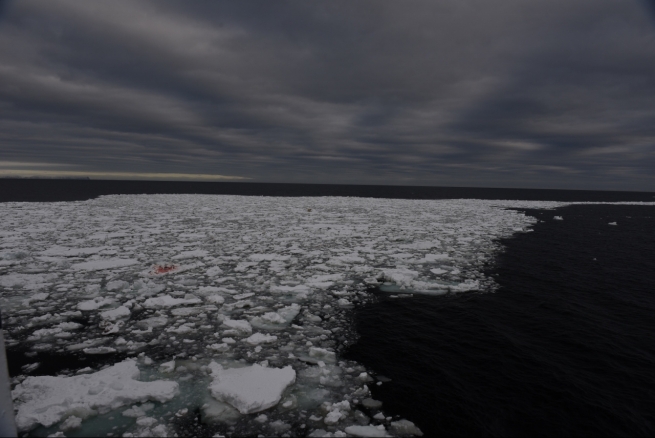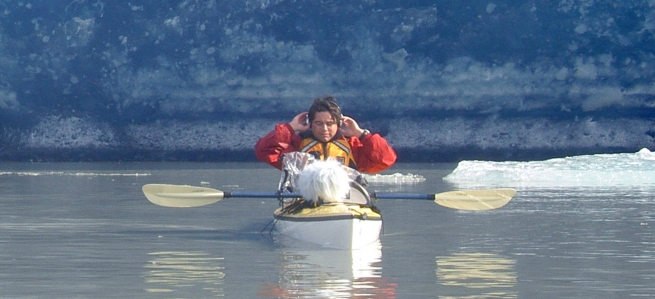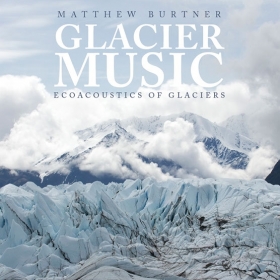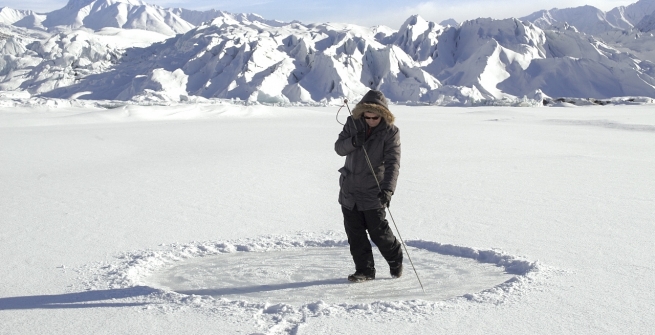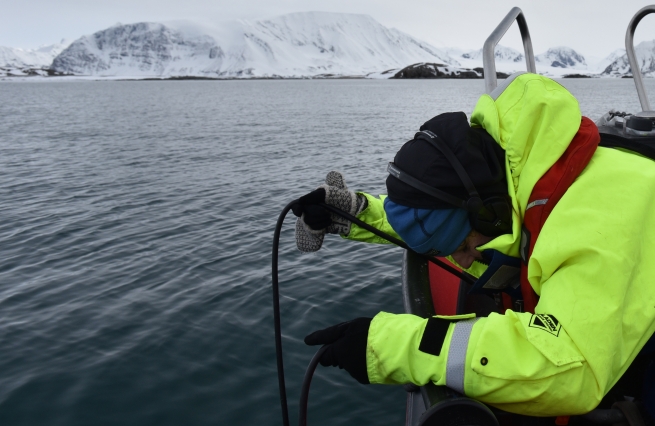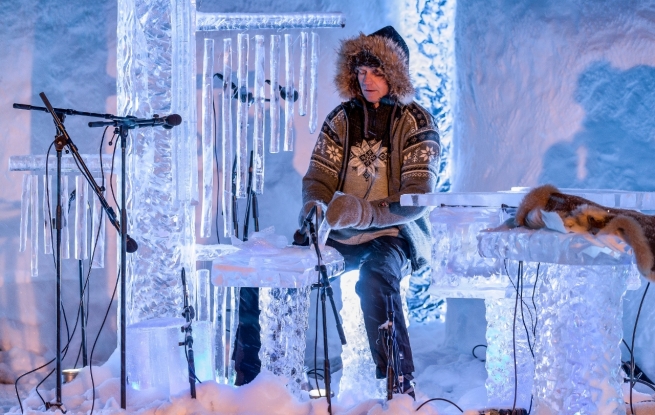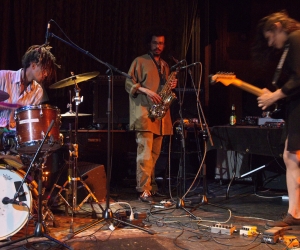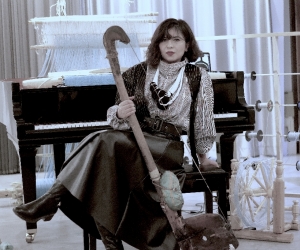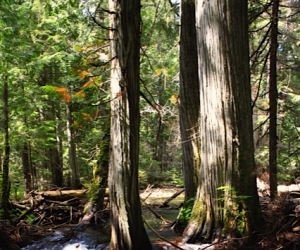A sad-looking polar bear drifts on a shrinking ice sheet in a vast, deep-blue sea under a bright, blue sky. Scenes like this have long been used to illustrate climate change, and they are more than symbolic. Polar regions are warming at more than twice the rate of the rest of the world. The melting of sea ice not only destroys wildlife habitats, it also negatively affects the livelihoods of Indigenous people such as the Inuit. These are not the people whose consumptive lifestyles filled the Earth’s atmosphere with carbon dioxide, yet now they are seeing their lands and ocean seized by economic imperialists who wish to open the Arctic to more resource exploitation—causing more warming.
Within our lifetimes, we may witness an ice-free Arctic Ocean, which would forever change the fates of circumpolar countries, including Canada, the United States, and Norway. Four sound artists and composers from these countries are bearing witness to this tragic transformation by using Arctic ice as sound source, instrument, or inspiration—before it vanishes forever. From the tinkling of glacial ice melt to the cracking of fragile frozen surfaces, the phase-change of water from solid to liquid offers our ears countless opportunities to hear the earth’s response to our carelessness.
‘I never thought that music was as exciting as a storm.’
Matthew Burtner is floating in a kayak in the Gulf of Alaska, listening to a glacier. It is over a kilometre away at the water’s edge, but his sensitive microphone—encased in a furry white windsock—brings its crackles directly into his earphones. After he has patiently waited the entire afternoon, the sonic moment arrives: the rumble and crash of a massive block of ice calving off the face of the glacier, sinking into the ocean, and quickly resurfacing as an iceberg.
This is not your typical electroacoustic music studio. The Anchorage-based composer and sound artist has built a body of work based on field recordings of the glaciers of his Alaska homeland. In this remote environment, one forgotten data card can scrub an expedition. One flipped kayak could end it all. “In a fraction of a second, you can go from having a beautiful day to a life-threatening situation,” says Burtner. “The best, most active sound of a glacier is going to be right where it’s the most dynamic and the most changing. If you could get your microphone right up to a face of ice as it’s calving off, that would be an ideal sound to record. But a giant, skyscraper-sized piece of ice—you don’t want to be anywhere near that!”
Born and raised in rural Alaska, Matthew Burtner was drawn at a young age as much to music as to the sounds of the natural world. He would spend his days practising his saxophone on his parents’ fishing boat, the beginning of a lifelong dialogue. “I started wondering what it would be like to bring the power of environmental sound into music. I never really thought that music was as exciting as, say, a storm. There was some intensity that was missing for me in human music.
“I started studying music in the ’90s, just as we were noticing the dramatic effects of climate change in Alaska. Places that I loved, glaciers that I knew very well, were suddenly disappearing. New kinds of plants were coming up on the mountain and changing the tree line. As the climate warmed, the permafrost was melting and locations that used to be solid, you couldn’t go there anymore because they were swamps.”
Inspired by the works of Iannis Xenakis, Burtner became equally drawn to computer music and software development. Combining these converging interests, he began referring to his practice as ecoacoustics, borrowing a term he’d seen in a scientific paper. Drawing from, yet also diverging from, the acoustic ecology work of Canadian artists such as R. Murray Schafer, Barry Truax, and Hildegard Westerkamp, Burtner strove to scientifically embed environmental sound and data into musical forms.
“Ecoacoustics is the study of sounds or vibrations in the natural world. Field recording is one of the core techniques of the field, but it also can happen through techniques like sonification, where you don’t necessarily have a sound like, say, ice extent in the Arctic changing over a decade. While that’s a pretty compelling piece of data, it doesn’t make any sound—but you can take the data and map it into sound.”
For Burtner, telling the story of climate change is a matter of finding the meaning in noise. Sound can tell us something that our eyes alone might not be able to ascertain: “There’s a time in an advanced stage of melt where a glacier doesn’t appear to recede. You come back year after year and it’s still where it was the year before. You might think, ‘Oh well, the glaciers not melting anymore, right? It’s healthy.’ In fact, what’s happening is it’s thinning. The ice is melting underneath and coming off in rivers on either side. When you hear those two rivers, you can tell right away that this is a glacier that’s in its advanced stage of retreat, because now it’s making this distinct sound.”
Five of Burtner’s most compelling works, created by recording and mapping glaciers over the better part of a decade, are collected on the album Glacier Music (Ravello Records, 2019). Though the Alaskan landscape is the star of the show, the glittering sounds of snow, streams, and compacted ice are layered with the performances of percussionists, a string quartet, and a chamber ensemble. The Rivanna Quartet and the Albemarle Ensemble are featured in Sound Cast of Matanuska Glacier, a multichannel surround-sound installation and concert work that was originally created in 2015 as a stereo sound piece at the behest of the U.S. State Department; the final iteration, presented in 2019, used eight years’ worth of glacier recordings. “With field recording in general, the chances of actually recording what you set out to find are small. Every time I would go to the glacier, I would hear something different. But by revisiting it many times, I had collected many different kinds of sounds. When we hear that piece in a gallery, we can wander around inside the glacier—it’s a fantastic experience on good speakers.”
Sonic Physiography of a Time-Stretched Glacier, the second track, features percussionist Brandon Bell and employs extended recording and production techniques that enhance listening. “When you’re standing on a glacier, you hear it sounds like a stream running,” Burtner says. “Each little rivulet of water is following the shape, the contour of the ice. And if you zoom in on one, it’ll make a specific rhythm, which repeats itself like a loop. Then you move the microphone over an inch to another one and it’s doing something else. What I thought to do with this piece was to time-stretch that field recording so you could start hearing that complexity. It was a way of uncovering this incredibly rich, hidden musicality of the glacier.”
Closing the album, Muir Glacier, 1889–2009, a sound installation based on Thomas Hill’s painting Muir Glacier (1889), was created for the Anchorage Museum and presented alongside the artwork that inspired it. The glacier has almost completely retreated since Hill painted it 120 years ago. “And I thought, Let’s do a sonification of Muir Glacier and map its retreat as a piece of sound art. It was exhibited like that for a while, and then it was taken down. There might have been some pushback from some museum visitors who didn’t appreciate this climate-change piece being superimposed over the Romantic-era painting.”
Burtner has also written the score and libretto for what may have been the world’s first climate-change opera: the multimedia work Auksalaq—the Iñupiat word for melting snow and ice—premiered October 29, 2012, and has recently taken on new relevance. It is a telematic opera for voices, instrumental ensembles, percussion quintet, computer sound, and video, which is designed to be performed between multiple locations around the world, thanks to the wonders of Internet streaming; a statement on the global impact of warming. Today, under COVID-19, remote music collaboration remains a holy grail—kept out of reach only by the challenge of latency. “The music was actually composed to take advantage of that,” offers Burtner. “I knew going into it that we would not be able to synchronize precise rhythmic events across multiple sites, so I didn’t even try to do that in the score. It uses a kind of heterophonic technique: A chorus will sing the same melody, but they don’t line up. It’s just kind of chaotic.”
Auksalaq made use of a software platform Burtner co-invented called NOMADS, which can also be used as a teaching tool. In Auksalaq it offered audiences a social-networking chat feature, allowing for the kind of in-concert discussion that would be verboten at a traditional opera. “At one of the last performances [in 2019], I looked up at that chat and it was just going off. It was a really deep discussion about the Anthropocene. They were talking about more advanced issues of climate change and science and policy than the opera can even begin to address. It’s a period piece by now, because our thinking on climate change has evolved. I thought it was just fantastic.”
Though Burtner is sanguine about global climate policy changing under the new U.S. administration, he’s also realistic about whether the warming trend can be reversed within our lifetimes. “We’re going to see a lot more catastrophic change in the next thirty years, no matter what we do now. Of course, the hope is to take a long-term view. I want to contribute to the work of scientists and policy leaders however I can through music. Let’s be real about it: the music’s not going to solve anything, but it can help. Where we could really be making a difference is to think more generationally. What I would like to see is music helping people come to terms with the fact that we can’t be the centre of the planet. It can’t just be about us and our own personal wishes. We need to accept that we are part of the planet.”
‘It’s about bearing witness to the landscape’
[In 2011] I interviewed Paul Walde for a Musicworks article that explored how his interdisciplinary work connects nature and culture; since then, climate change has only intensified, and the Canadian artist’s engagement with the issue only deepened. Walde first became intrigued—and concerned—by the melting of the permafrost during a visit in the early 2000s to the Yukon, after which he created an installation piece that included samples of permafrost he had preserved in freezers.
Shortly after moving to British Columbia to join the University of Victoria, Walde was invited to create a new piece for the Langham Cultural Centre, located on Kootenay Lake in the B.C. interior. Two years in the making, Requiem for a Glacier is a video installation and site-specific performance memorializing the Jumbo Glacier area, known as Qat’mak by the Ktuxana people. The centrepiece of Requiem is a four-part oratorio, inspired in part by Mozart and Britten. Walde assembled an orchestra and choir made up of volunteers from the region, who hiked four hours up Jumbo to perform the piece on—and for—the glacier. The libretto is a Latin translation of the B.C. government’s 2012 press release approving the development of a ski resort that was first proposed in 1991.
“I really wanted it to be for the glacier,” Walde explains. “I didn’t want it to be a spectacle, I wanted it to be solemn. It took it out of traditional performance and made the glacier the audience.” The stately, mournful piece is a hard-hitting expression of climate grief, but also a meditation on the passing of time. The Jumbo story had a happy ending. In January 2020, it was announced that the resort would not be built, and the area would become a conservation zone.
For his next major climate piece, Alaska Variations, Walde was invited by the Anchorage Museum to spend a month in the state’s biggest city, during which he came up with an idea to stage a mini-opera in an abandoned bar. Though that concept was shelved, a gritty DIY punk spirit informed Alaska Variations—performative compositions inspired by the landscape around Anchorage. This took the form of eleven video installation works; a vinyl album was also pressed. For the piece Ice Record, Walde scratched on the surface of a frozen lake like a human record player, only using a large metal stylus fitted with a contact mike..
Two works in progress are concerned with Mount Baker, a Washington state landmark that Walde can see from his living room in Victoria: “It’s part of our landscape here, it’s like our Mount Fuji.” Glacial is based around field recordings of the mountain’s Coleman Glacier, modified by string and percussion instruments used as acoustic signal processors. Walde finds it sobering to realize the impact icemelt is having so far from the poles. “It’s the snowiest place in North America and it’s melting quite significantly. When we were there in 2019, there was a warning to climbers that a major ice bridge had collapsed.” Kulshan, meanwhile, will be a twelve-hour video work to be based on the artist’s own planned trek to the summit, an expedition currently on hold due to COVID-19. But he wishes to disavow any notion of this piece being some kind of heroic quest.
“It’s not about mountain climbing, or conquest. It’s more about bearing witness to the landscape. As an artist, I need to go there, to see it and understand.”
‘We need to tread more carefully’
The work of Norwegian sound artist Jana Winderen, who has a background in biochemistry and fish ecology, resides in the deep waters of the ocean. Her musical instrument is the hydrophone—a microphone designed to record sound underwater.
In her practice—which encompasses installations, performances, recordings, talks, and research—Winderen uses audio to foster a greater understanding of the lives of undersea creatures. Fish, insects, crustaceans, and mammals all communicate with sound, which travels faster and farther through water than do light or scent. “We are not really thinking about how sound is affecting and masking the communication that is happening,” she says. “We need to tread more carefully around the environments we are sharing with other creatures on this planet, including the ocean, which has been treated like a dumping ground.”
The melting of Arctic sea ice opens up the ocean to more noise pollution from the surface—not just from increased boat traffic but also from rain and storms, thus changing the underwater soundscape. Winderen explored these changes in her thirty-five-minute work Spring Bloom in the Marginal Ice Zone (2018). To create this piece, the Oslo-based artist undertook field trips to the far north of Norway and Russia on the Barents Sea as well as to the North Pole. Standing on the top of the world, she dropped her hydrophone through a hole in the ice.
(The Barents Sea is a marginal sea, a division of an ocean, bordering continents, semi-isolated from open ocean by island arc or land ridge, and underlain by oceanic crust.)
The sparkling crackle of fractured ice and the lonesome songs of migrating whales tell the story of the marginal ice zone—the point where sea ice gives way to open water. The drawing of this line has become politically contentious in oil-dependent Norway, as this determines the northern limits of drilling. The zone is at the forefront of climate change, and the annual bloom of phytoplankton may foretell how the Arctic ecosystem will change in the very near future. “The photosynthesis is very active in the spring, because there’s more light and the ice is melting. It’s also a very important carbon sink due to this production of oxygen. This is ice that then slowly goes over to Canada. But now it’s not building up anymore, it’s getting thinner.”
Winderen, who has also worked in warmer water (Panama and Thailand), recently coauthored a paper published in the journal Science entitled “The Soundscape of the Anthropocene Ocean.”
‘Nature is the boss’
For more than twenty years, Terje Isungset has been sculpting his own genre, which he calls ice music, carving blocks of frozen H2O into wind, percussion, and even string instruments—all of which are playable during their limited lifespans. While Jana Winderen approaches climate-inspired music as science, Isungset approaches it more like spirituality. “I am very connected to nature, and I have been this way all my life,” he says. “And not in a religious way, because I’m not religious at all. But with ice, you have to trust nature. It decides everything with the music. It decides the quality of the sound, depending on how the ice freezes. Imagine if you’re playing a piece on a piano and you don’t know if the piano will have sound or not.”
A low-key mystic with a long history as a percussionist in Norway’s jazz scene, Terje Isungset conducts a practice that is about bringing music back to its origins in the natural world, performing on wood, rocks, and animal bones. His interest in ice began when he was invited to perform a concert at a frozen waterfall in Lillehammer in 2000. A year later, he independently released what he claims was the world’s first ice-music recording.
In Isungset’s ice music, there is a quiet intimacy. But performing and recording it comes with its own set of challenges, related to the ephemeral nature of the instruments. “It’s very important to have a stable temperature, and a place that is silent. No noise, because some of the ice instruments are very soft-sounding. We need to gain everything up really high and sometimes the noisiest part will be my stomach!”
The shimmering, crystalline tones that Isungset draws from the blocks of an iceofon (ice marimba)—which he strikes or taps with gloved hands—can be mesmerizing for audiences. For his ice horns, he uses a piece of leather, given to him by one of the Sámi people, to protect his lips. This sense of spectacle extends to the Ice Music Festival Norway, which the artist has organized annually since 2006, and which take place inside structures made of ice and snow. These gatherings in the cold, dark, remote Norwegian winter bring together musicians, dancers, architects, and poets, as well as scientists giving talks on the effects of climate change.
Although the 2021 edition of the festival was cancelled due to COVID-19, Isungset organized a virtual concert entitled On Nature’s Conditions, which he describes as “an interdisciplinary climate-related project, where nature will control the environmental conditions,” or more succinctly, “Nature is the boss!” Isungset performed solo on an iceofon from within an igloo, while outdoor solo-dance and visual ice-arts performances happened simultaneously. The artist viewed the event as a way of dealing with both climate grief and loneliness.
“Human beings, we are very small and not very important at all,” muses Isungset. “And we’ve been on the planet such a short time, like one millisecond and then we destroy everything . . . and then it’s goodbye.”
Top Photo by Jana Winderen. Matthew Burtner photo and Glacier Music cover by Matthew Burtner. Video still of Paul Walde performing Ice Record (part of Alaska Variations) taken by Michael Conti. Photo of Jana Winderen hydrophone recording in the Barents Sea taken by a crew member of R/V Helmer Hanssen research vessel. Photo of Terje Isungset taken by Emile Holba.
